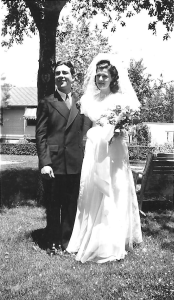
Biography
Paul Warren Faulkner was born in North Platte, NE in 1913. He was educated first in the North Platte schools and then at the University of Nebraska, where he received his BA degree in 1935. He went on to study at the Art Institute of Chicago, where he studied with the muralist Edgar Britton and received his MA degree in 1937. While Faulkner was living in North Platte he traveled broadly, including a painting trip to Southern California in 1938. In 1939 his work was exhibited at the New York World's Fair and the Golden Gate International Exposition in San Francisco. He also assisted Britton in two murals for the Department of Interior Building in Washington, DC, both relating to the petroleum industry.
In 1940 Faulkner married the potter Elsie MacDonald. They had two children, Roland (b.1941) and Sonja Maria (b.1944). Faulkner completed a Post Office mural "Winter Sports" for Kewaunee, WI in 1940 and a second Post Office mural "Farm Scene" for Clarion, IA in 1943.
Faulkner became an instructor at the Layton School of Art in Milwaukee. From 1958-1977 he worked as an art instructor at the Norwich Free Academy in Norwich, CT. His wife instructed pottery at the Academy as well. Faulkner died in Uncasville, CT in 1997.

Critical Analysis
Faulkner's murals are interesting, subtle and engaging. His "Winter Sports" shows a scene of skaters on a frozen river from a distant vantage point at the top of a ski and toboggan slope. Seeing the sledders poised to hit the slope, the viewer has a keen sensation of the upcoming steep descent and almost feels drawn to to join the sledders as they race down to the lake. Skaters are all over the ice on the river, stretching out of sight toward the distant buildings.
Faulkner's "Farm Scene" has a very different tone. It depicts a different season, so the colors are green, not the brown earth of the "Winter Sports" mural. But the viewer's first impression of a prosperous farm - with various farm animals on display and farm machinery being inspected - would be entirely erroneous. The display and the inspection are not shows of prosperity, but of desperation, and what's taking place is a foreclosure of the farm. In this subtle way Faulkner shows the catastrophe that the Depression brought to many farm families, but you have to look closely to understand the irony of a prosperous-looking farm that couldn't generate enough income for the farm family to survive. Only one other mural funded by the Treasury Department's Section of Fine Arts dared to explore this delicate topic. Kenneth Evett's Pawnee City, IA mural "The Auction" was in fact quite unpopular with the citizens of Pawnee City, perhaps because it looked grim even at first glance, while Faulkner's "Farm Scene" misleads the viewer's first impression and provides its true message only upon further study.
Murals
- Clarion, Iowa - Post Office: Farm Scene
- Kewaunee, Wisconsin - Post Office: Winter Sports
References
- HistoryLady1, Kewaunee Post Office: Fodder for a Novel, Kewaunee County History January 11 (2024).
- Paul Faulkner (Wikipedia).
- Paul Faulkner, Was NFA art teacher, The Day (New London and Southeastern Connecticut) January 6 (1997).
- Paul Warren Faulkner (Find a Grave).